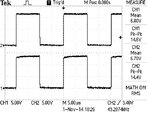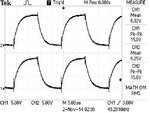[SOLVED] direct PWM to MOSFET
- Thread starter P.Copper
- Start date
- Status
- Not open for further replies.
dick_freebird
Advanced Member level 7

"A" MOSFET could be anything from a couple hundred pF to
tens of nF load at the FET driver output. You should have at
least 10X Cgg as close-in decoupling at the driver and probably
this should be a 1X low-ESR/ESL and a 10X bulk cap.
I do not see the usual "porch" about mid-swing and so suspect
that the MOSFET does not have -its- load, yet.
MOSFETs don't need 10V to switch on; they need (old ones,
anyway) 10V to have Ron fully driven to minimum. VT is more
likely 3-4V.
I recommend you play with LTSpice or TINA, depending on
which one might have the closest and best model for the
driver and FET in question. See what a simple lashup shows
for the same probe-points and conditions.
To me this only looks like too much capacitive load for the
drive strength of the FET driver. Which may or may not be
the driver's fault entirely - is your board holding up its end,
especially regarding power and ground trace resistances?
tens of nF load at the FET driver output. You should have at
least 10X Cgg as close-in decoupling at the driver and probably
this should be a 1X low-ESR/ESL and a 10X bulk cap.
I do not see the usual "porch" about mid-swing and so suspect
that the MOSFET does not have -its- load, yet.
MOSFETs don't need 10V to switch on; they need (old ones,
anyway) 10V to have Ron fully driven to minimum. VT is more
likely 3-4V.
I recommend you play with LTSpice or TINA, depending on
which one might have the closest and best model for the
driver and FET in question. See what a simple lashup shows
for the same probe-points and conditions.
To me this only looks like too much capacitive load for the
drive strength of the FET driver. Which may or may not be
the driver's fault entirely - is your board holding up its end,
especially regarding power and ground trace resistances?
BigBoss
Advanced Member level 7

This is because of "Gate Capacitance" and "Series Resistance" on the path if there are some resistive elements on the road.It's typical R-C time domain response and you should use a buffer which is capable to drive this capacitive gate.Because of signal generator impedance and unsufficient driving capabilities of the generator the waveform is shaped..
P.Copper
Member level 5

what do you mean by
.is your board holding up its end,
especially regarding power and ground trace resistances?

- Joined
- Jan 22, 2008
- Messages
- 53,701
- Helped
- 14,811
- Reputation
- 29,919
- Reaction score
- 14,439
- Trophy points
- 1,393
- Location
- Bochum, Germany
- Activity points
- 303,603
Which MOSFET? Any external Rg connected? Without this information, your post is about to useless.
chuckey
Advanced Member level 6
1. Your drive has a very short risetime, have you worked out the DV/Dt, then apply this to the input capacity of the FET, hence you can find the charging current. Where is this charging current coming from?
2. The waveform on the FET gate shows a CR time constant of about 2.5µ S (100%Vg @ 10µS). we know where the C is coming from what about the R?.
From 1 does the supply to the driver dip? from 2 is there some series resistor to the FET gate?
Frank
2. The waveform on the FET gate shows a CR time constant of about 2.5µ S (100%Vg @ 10µS). we know where the C is coming from what about the R?.
From 1 does the supply to the driver dip? from 2 is there some series resistor to the FET gate?
Frank
kripacharya
Banned
What are these TWO traces of ? Are these 2 separate signals each driving a mosfet or what ?
Audioguru
Advanced Member level 7
- Joined
- Jan 19, 2008
- Messages
- 9,461
- Helped
- 2,152
- Reputation
- 4,304
- Reaction score
- 2,012
- Trophy points
- 1,393
- Location
- Toronto area of Canada
- Activity points
- 59,764
The Agilent Mosfet driver does not have enough output current to quickly charge and discharge the high gate-source capacitance of your Mosfets at 49kHz. It will be much better at 4.9kHz but then you will hear it.
P.Copper
Member level 5
What are these TWO traces of ? Are these 2 separate signals each driving a mosfet or what ?
no, the first trace is the gate signal before i connect it to the mosfet, the second is after connecting it
- - - Updated - - -
Which MOSFET? Any external Rg connected? Without this information, your post is about to useless.
i'm using IRFB4229Pbf
Audioguru
Advanced Member level 7
- Joined
- Jan 19, 2008
- Messages
- 9,461
- Helped
- 2,152
- Reputation
- 4,304
- Reaction score
- 2,012
- Trophy points
- 1,393
- Location
- Toronto area of Canada
- Activity points
- 59,764
The capacitance of your Mosfet is very high. You need a gate driver that provides much more current to drive it quickly.
P.Copper
Member level 5
I do have a gate driver circuit, i used the HCPL 3120 gate driver but the problem still persists. how much more current specifically? the HCPL that i'm using gives out 2A.
Last edited:
Audioguru
Advanced Member level 7
- Joined
- Jan 19, 2008
- Messages
- 9,461
- Helped
- 2,152
- Reputation
- 4,304
- Reaction score
- 2,012
- Trophy points
- 1,393
- Location
- Toronto area of Canada
- Activity points
- 59,764
Are you testing the circuit on a solderless breadboard that has contacts that cannot pass 2A of current to the gate?
Then the contacts and wiring are resistors that slow down the risetimes and falltimes.
Then the contacts and wiring are resistors that slow down the risetimes and falltimes.
schmitt trigger
Advanced Member level 5
The oscilloscope plots show the "classic" resistance-capacitor charging and discharging waveforms from a squarewave source.
You have way too much an R*C product for the switching frequency.
Since most likely the "C" is fixed by your Mosfet, you have to lower "R"...as simple as that.
So the question is:
-Is there any series resistance anywhere, and that includes stray resistance, and the gate driver's power supply resistance?
You have way too much an R*C product for the switching frequency.
Since most likely the "C" is fixed by your Mosfet, you have to lower "R"...as simple as that.
So the question is:
-Is there any series resistance anywhere, and that includes stray resistance, and the gate driver's power supply resistance?
crutschow
Advanced Member level 6
- Joined
- Feb 22, 2012
- Messages
- 4,572
- Helped
- 1,006
- Reputation
- 2,010
- Reaction score
- 1,162
- Trophy points
- 1,393
- Location
- Colorado USA Zulu -7
- Activity points
- 26,054
The IRFB4229Pbf driver appears to be able to deliver adequate current to drive the MOSFET capacitance to give less than a 100nS rise-time so there appear to be some external resistance in the circuit, as others have noted.
Post your schematic.
Post your schematic.
Audioguru
Advanced Member level 7
- Joined
- Jan 19, 2008
- Messages
- 9,461
- Helped
- 2,152
- Reputation
- 4,304
- Reaction score
- 2,012
- Trophy points
- 1,393
- Location
- Toronto area of Canada
- Activity points
- 59,764
Almost every time there is a problem with a circuit it is a solderless breadboard that is the culprit.
But maybe the Mosfet driver IC is in one city and the Mosfet is in another city?
But maybe the Mosfet driver IC is in one city and the Mosfet is in another city?
P.Copper
Member level 5
The oscilloscope plots show the "classic" resistance-capacitor charging and discharging waveforms from a squarewave source.
You have way too much an R*C product for the switching frequency.
Since most likely the "C" is fixed by your Mosfet, you have to lower "R"...as simple as that.
So the question is:
-Is there any series resistance anywhere, and that includes stray resistance, and the gate driver's power supply resistance?
Oh shoot!!!! for some reason I used a 270ohm resistor instead of a calculated 5.6 ohm resistor..
- - - Updated - - -
Are you testing the circuit on a solderless breadboard that has contacts that cannot pass 2A of current to the gate?
Then the contacts and wiring are resistors that slow down the risetimes and falltimes.
I'm testing it on a vero board, i'm not sure but i think i can handle up to 3A if i'm not mistaken. I stand to be corrected!
- Status
- Not open for further replies.
Similar threads
-
controlling mosfet biasing directly in the circuit question
- Started by yefj
- Replies: 2
-
-
-
-
Only 3.5V output in MOSFET logic gate with 9V supply?!
- Started by AxelanDerGrosse
- Replies: 3


